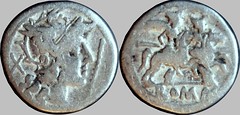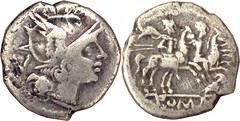Part 6 RRC 112 to RRC 138, 206BC to 190BC, Late second Punic war, regular Rome mint issues

|
Specialist Supplements:
1. Roman Coins of Luceria and Canusium
2. Anonymous Struck Bronze Coins of the Roman Republic
3. Anonymous Roman Republican Denarii and Victoriati (Steve Brinkman's site)
Principal Coins of the Roman Republic
Part 6 RRC 112 to RRC 138, 206BC to 190BC, Late second Punic war, regular Rome mint issues
RRC 112 staff silver
RRC 112 staff bronzes, RRC 113 denarius. Note the staff placement on the obverse of the quadrans.
RRC 113 star as, semis, imitative semis, RRC 113R star triens (not RRC 196). Although this website is arranged strictly in Crawford order, the trientes, quadrantes and sextantes of RRC 113 and RRC 196 were transposed in Crawford's RRC, and I've corrected that here. Richard Schaefer and Andrew McCabe clarified this in NC 2010, "A Fresh Look at Roman Republican Star bronzes, RRC 113 and 196", and recommended that the star-before triens, as above, be relocated in RRC 113, with the star-above triens moved to RRC 196.
RRC 113R star quadrans official issue (not RRC 196), RRC 114 rostrum tridens denarius, bronzes. The star quadrans is an official issue of the same prow style and dignified obverse bust style as the as and semis of RRC 113, and for the same reason as with the triens, this type is relocated to RRC 113. Note however that the vast majority of star-before quadrantes are unofficial later issues, of lighter weight, typically 4 grams, slightly erratic style and are not associated with either RRC 113 or RRC 196. As with the second star semis in the prior tray, the rostrum tridens semis in this tray is imitative. The semis is one of the most commonly imitated denominations of this era.
RRC 114 rostrum tridens bronzes, RRC 116 butting bull denarius, As, Ahala collection. The butting bull As is a very rare type.
RRC 117A/1 bird and rudder denarius. Davis coll.
RRC 117A/1 bird and rudder As, RRC 118 helmet bronzes, RRC 119 thunderbolt victoriatus, As.
RRC 119 thunderbolt bronzes. Once again, the semis is imitative.
RRC 120 knife denarius and bronzes
RRC 121 sow victoriatus and bronzes.
RRC 121 sow sextans, RRC 122 dog denarius and bronzes,
RRC 122 dog bronzes, RRC 123 ram or heifer semis, RRC 124 meta denarius. RRC 123 is so rare that the anatomy of the animal remains debatable, especially as worn specimens are easily confused with the sow series. Crawford thinks it a ram; Charles Hersh thought it a heifer. This specimen looks more like sheep than cattle. It cannot be a sow as it does not have neither the elongated body nor the pointed snout and does not have multiple udders, so it is RRC 123 in any event, whether ram or heifer. The RRC 124 meta denarius in this tray is among the rarest in the Republican series.
RRC 124 meta bronzes
RRC 125 QLC Lutatia denarius RRC 127 female head Horatia denarius, RRC 128 shield and carnyx Decia denarius, RRC 132 ME Caecilia victoriatus All silver from this period is scarce. The denarius with female head is traditionally associated with gens Horatia because it was restored by Trajan with the word Cocles, a cognomen of the Horatia gens, one of whom killed his sister Horatia about 650BC because she was grief-stricken when he killed the man to whom she was engaged; presumably the head is that of his sister. A descendant of this Horatius was the Publius Horatius Cocles who defended the Pons Sublicius against Lars Porsenna, in 508BC. The shield and carnyx denarius, a type associated with Gaul, is linked to gens Decia in commemoration of Publius Decius Mus who sacrificed himself in battle against the Gauls 295BC. These two examples illustrate just how tentative and uncertain are many of the attributions to Republican gentes.
RRC 131 staff and wing denarius, Davis coll. This type is presumably a rare variant of RRC 130 staff and feather.
RRC 132 ME Caecilia denarius and bronzes
RRC 133 TAMP Baebia victoriatus, denarii, semis. The semis is clearly imitative. The denarius at left with TAMP below the Dioscuri is a very rare variety made from just a single reverse die. Its rarity is not evident from Crawford which only comments on the combined issue.
RRC 133 TAMP Baebia quadrans, RRC 134 LPLH Plautia denarii, semis.
RRC 134 LPLH Plautia quadrans, RRC 135 owl denarius, RRC 136 AV Aurelia denarius and a Dacian imitation of the same type.
RRC 135 owl quinarius. This is a unique type, and an extremely rare example of a peaked-visor quinarius, the few examples of which are known in one or two specimens each. It seems the quinarius coinage ceased at a very early date, when only straight-visor or curved-visor denarii were struck. Later quinarii are of the highest rarity. Rottinghaus coll.
RRC 136 AV Aurelia bronzes, RRC 137 crescent bronzes. It's impossible to say whether RRC 136 represents AV or AN. I've taken it to be AV for Aurelia.
RRC 137 crescent bronzes.
Specialist Supplements:
1. Roman Coins of Luceria and Canusium
2. Anonymous Struck Bronze Coins of the Roman Republic
3. Anonymous Roman Republican Denarii and Victoriati (Steve Brinkman's site)
All content copyright © 2004-2013 Andrew McCabe unless otherwise noted. If you've any questions or comments please contact me on the Yahoo Group RROME: http://groups.yahoo.com/group/RROME.
Alternately you can leave comments against any coin picture, just click on the picture and write in the comment box.
Site hosted free courtesy of VCoins.com
Ancient Coins on Vcoins
comment: this page is RRC112.html

































